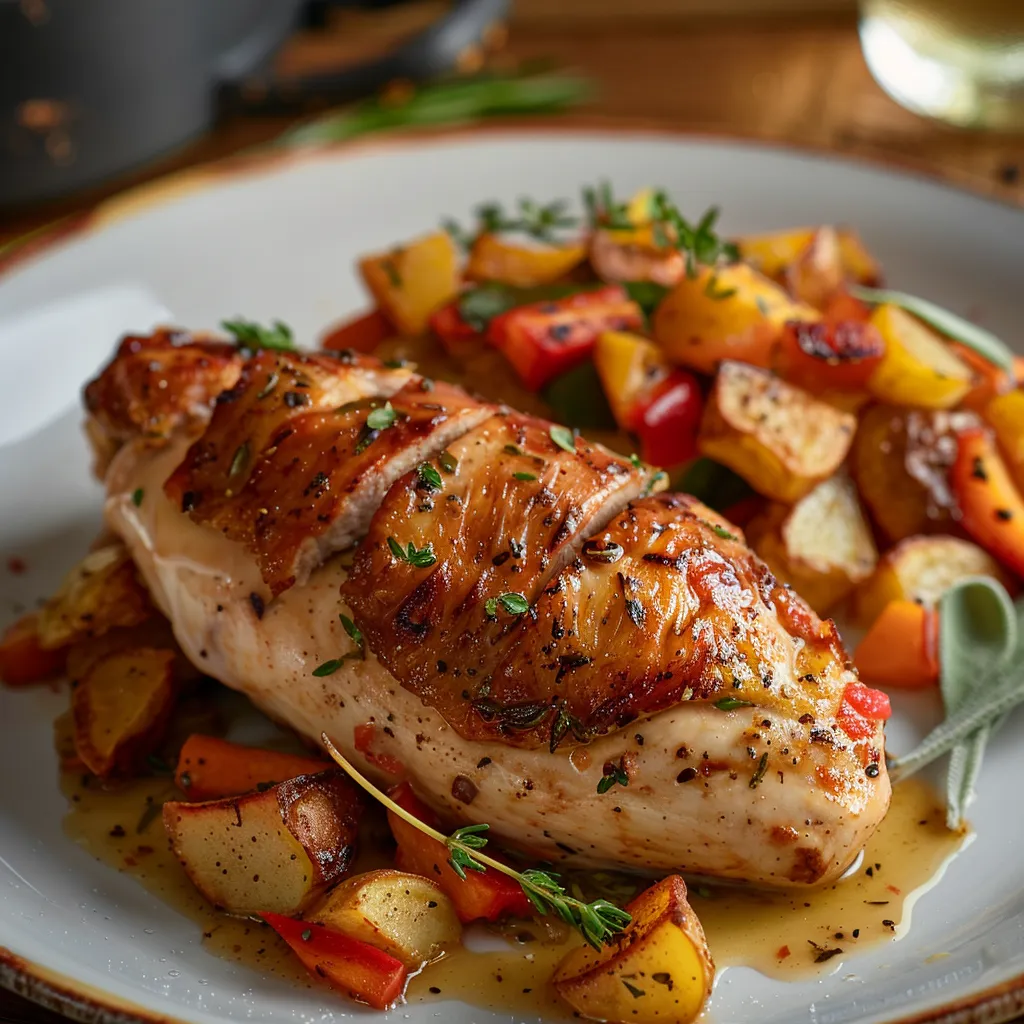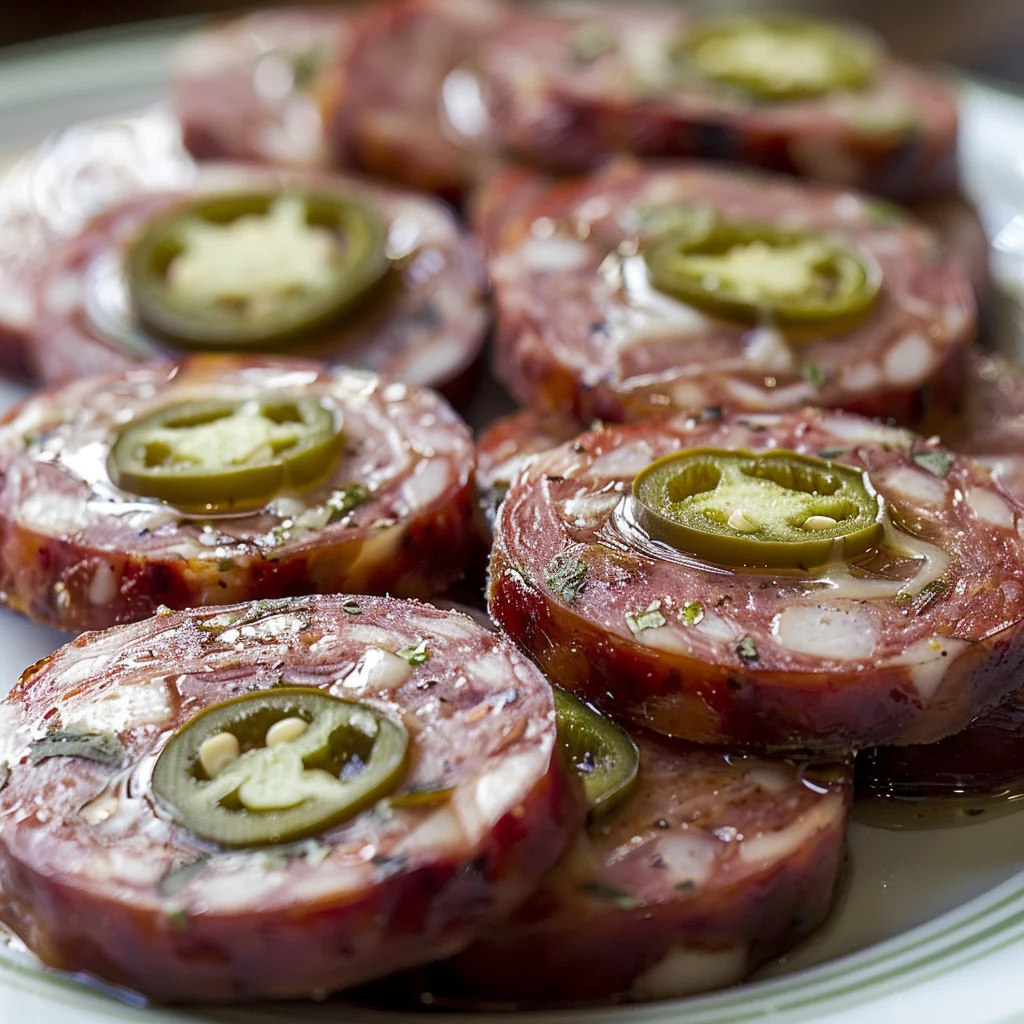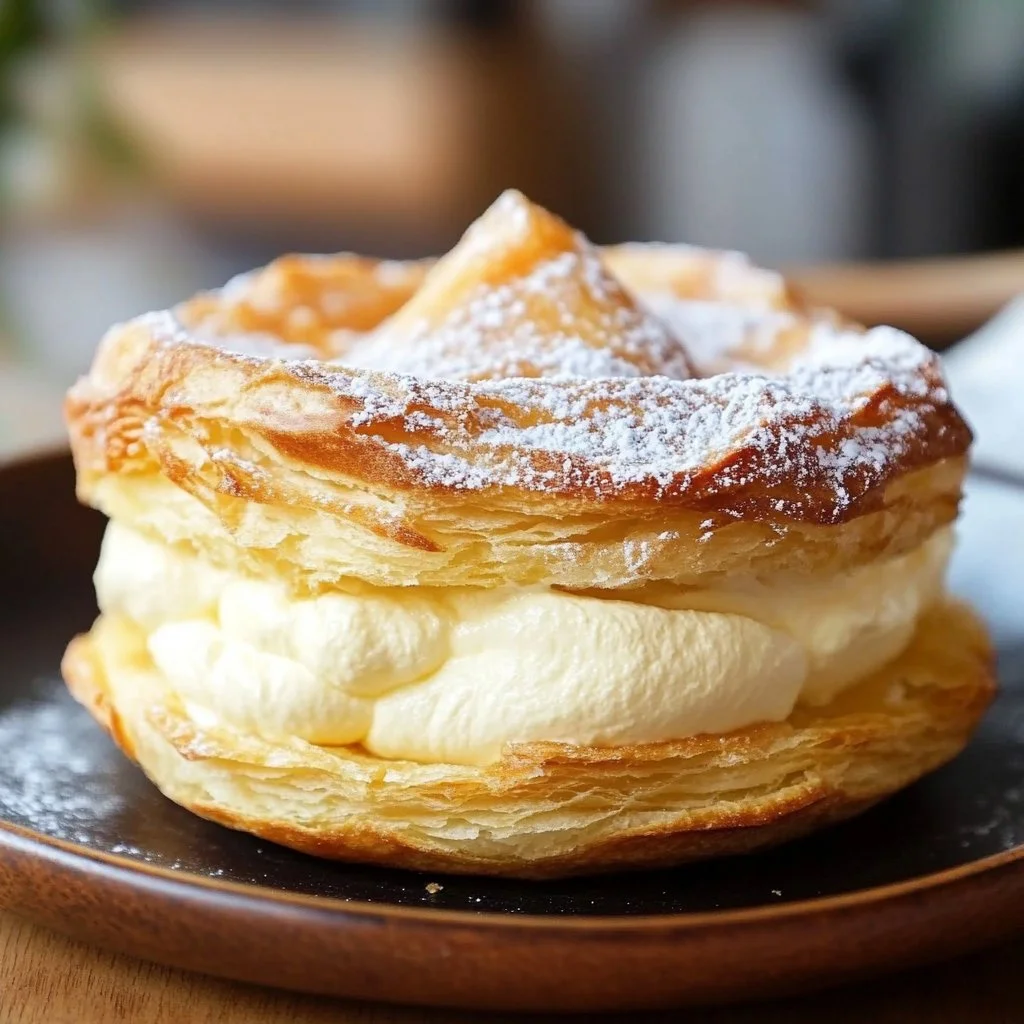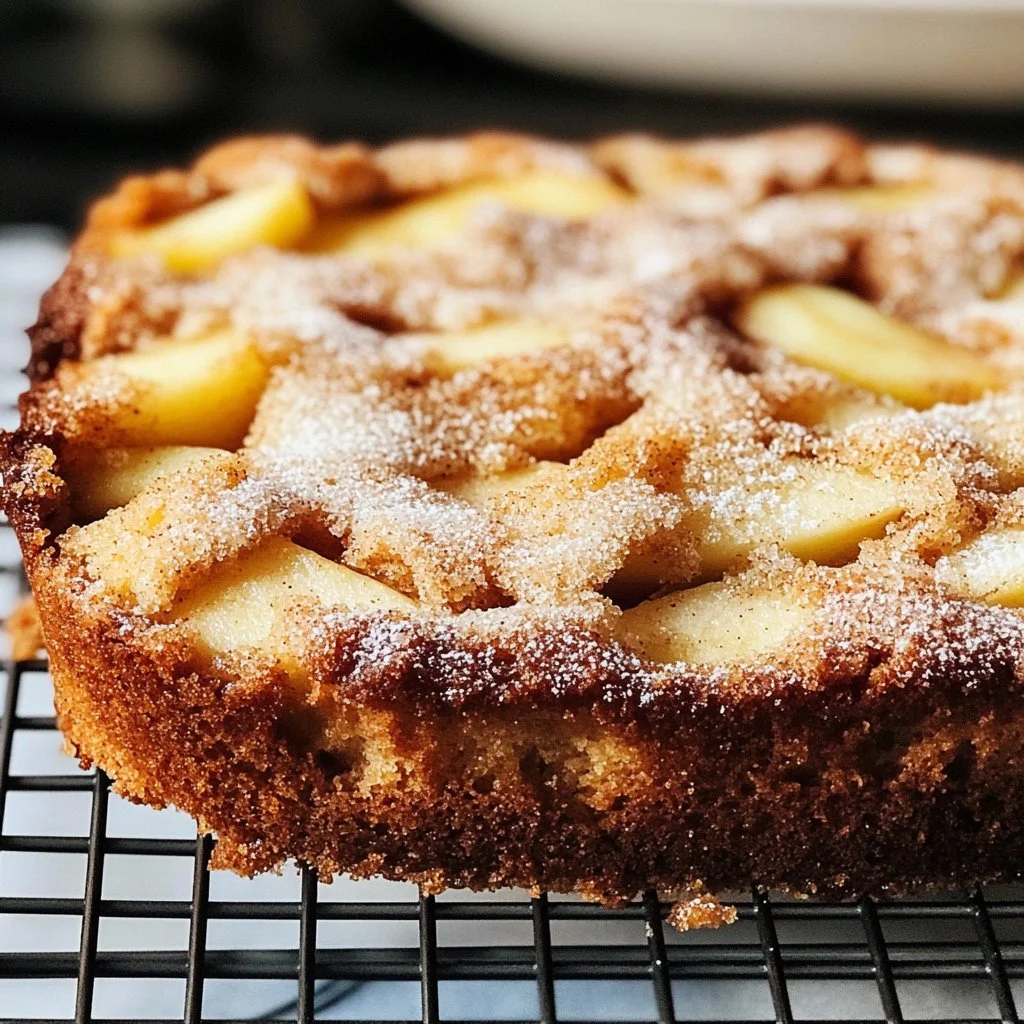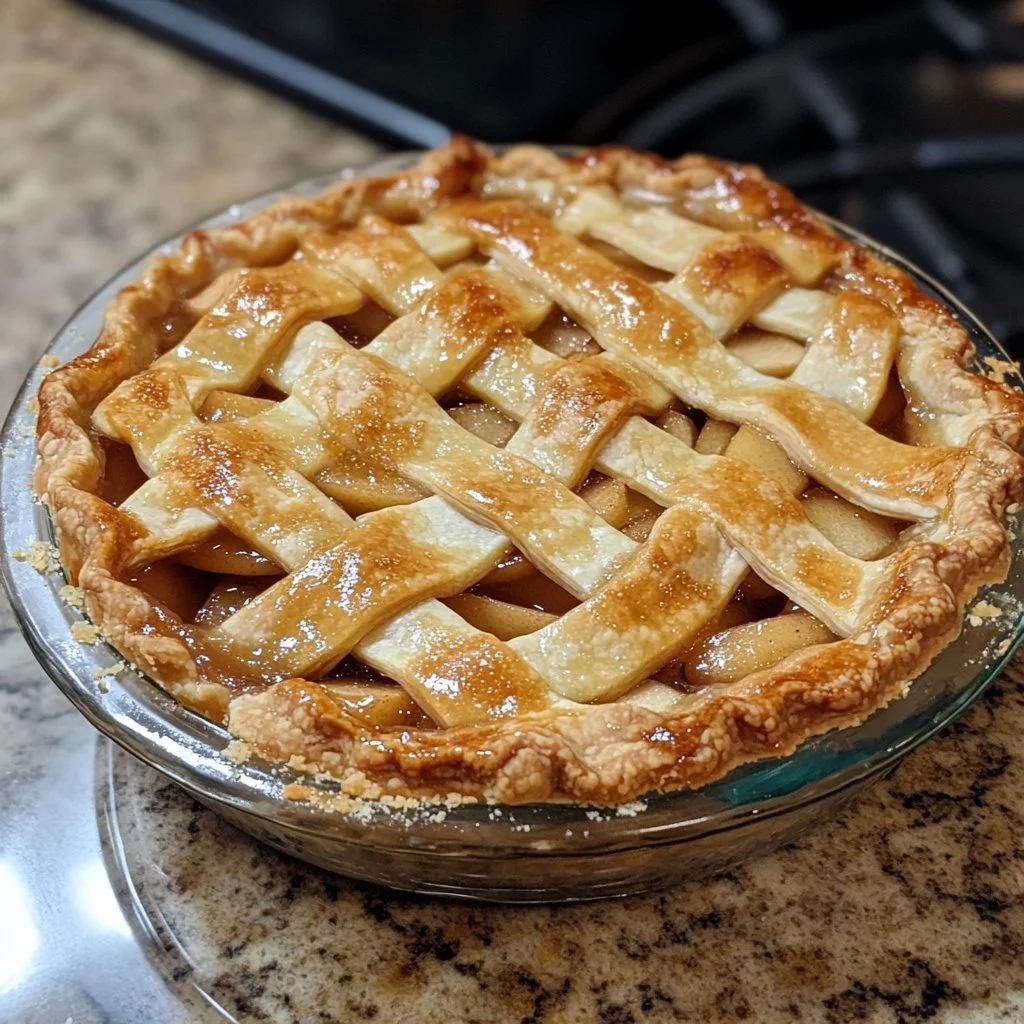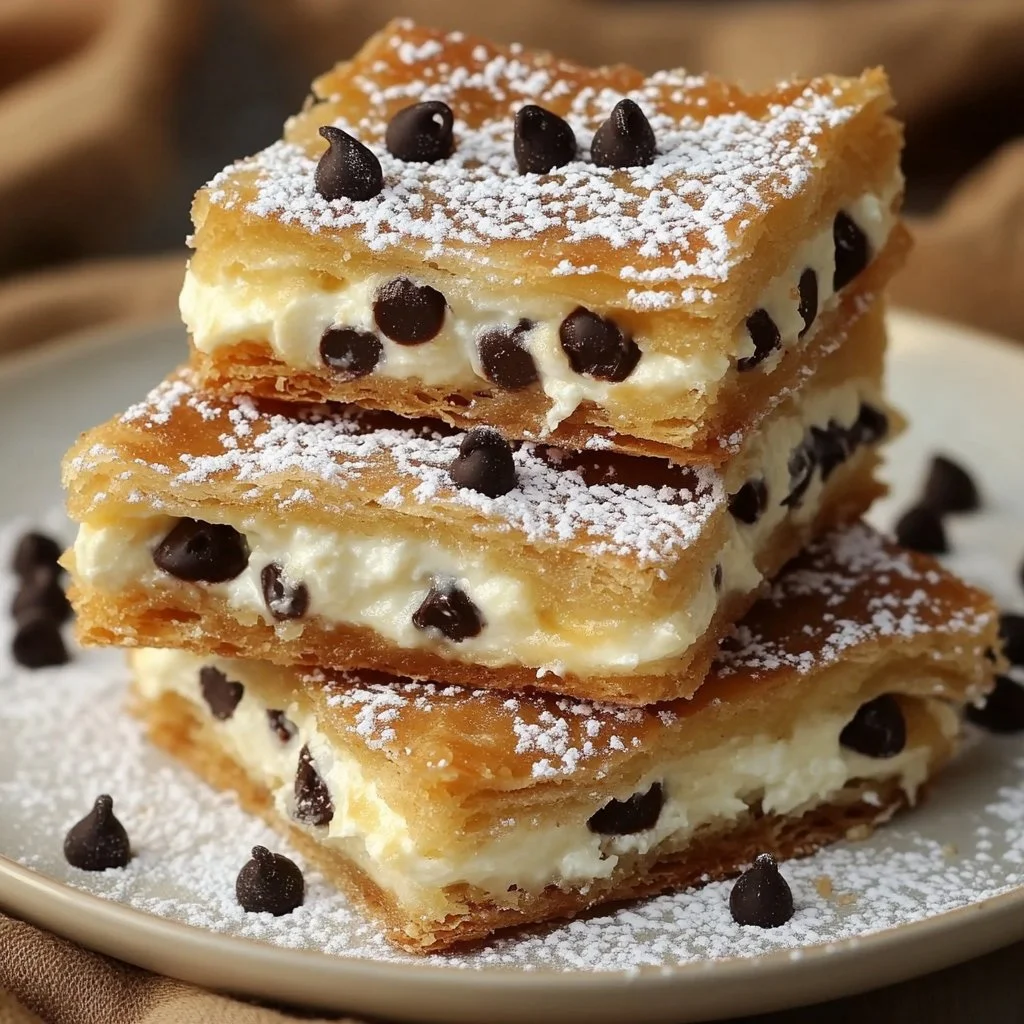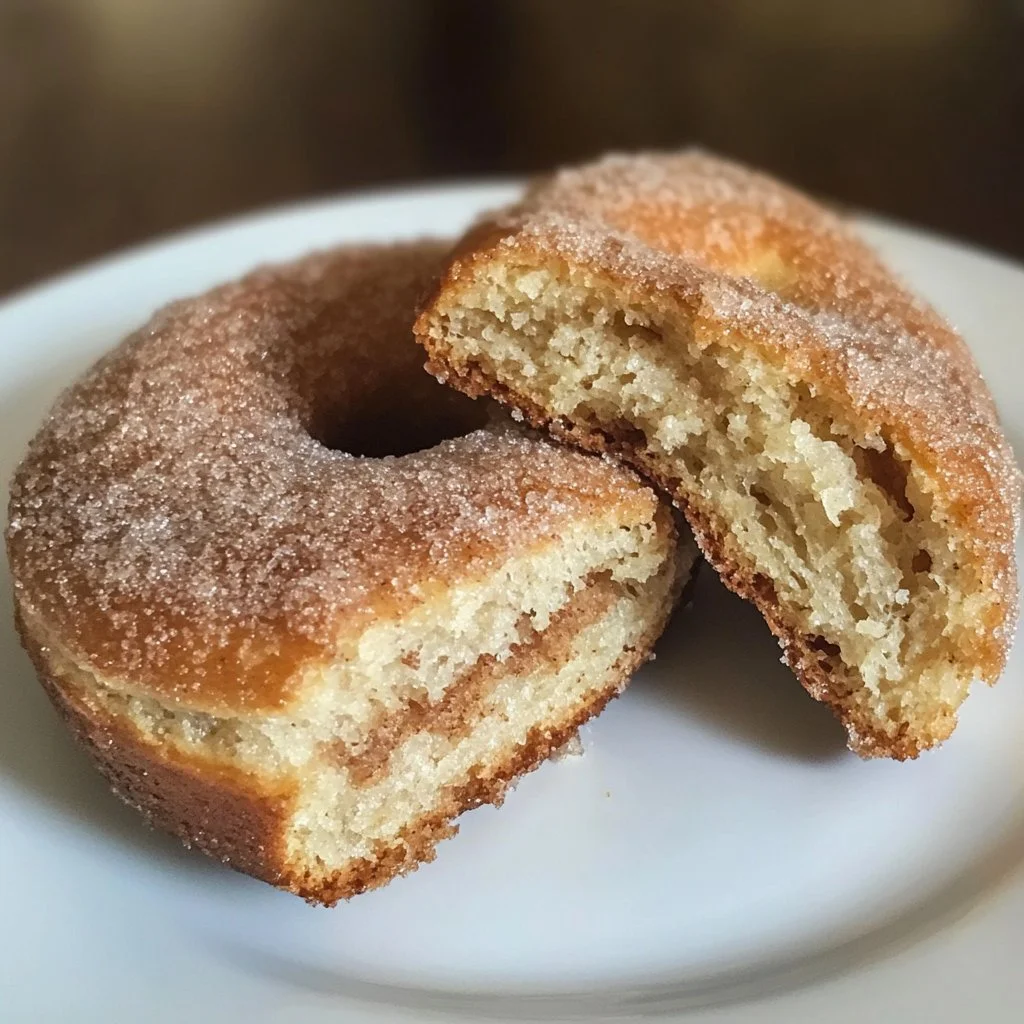📑 Table of Contents ▶
- Key Takeaways
- Essential Ingredients for Savory Stuffed Chicken Breast
- Selecting the Perfect Chicken Breasts
- Choosing Your Stuffing Ingredients
- Herbs and Spices for Extra Flavor
- Preparing Your Cooking Station
- Step-by-Step Instructions to Stuff Chicken Breast
- Preparing the Chicken for Stuffing
- Mixing the Savory Stuffing
- Stuffing Technique for Chicken Breast
- Secure the Stuffed Chicken Breast for Cooking
- Best Practices for Juicy Stuffed Chicken
- Oven Temperature and Cooking Time
- Tips to Prevent Dry Chicken
- Using a Meat Thermometer
- Delicious Side Dishes to Complement Your Meal
- Light and Fresh Salads
- Steamed or Roasted Vegetables
- Perfect Pairing With Potatoes
- How to Make a Homemade Gravy From Pan Drippings
- Collecting the Pan Drippings
- Flour or Cornstarch for Thickening?
- Seasoning and Serving the Gravy
- Creative Variations of Stuffed Chicken Breast
- Different Stuffing Inspirations
- Incorporating World Flavors
- Recipe Adaptations for Dietary Restrictions
- How to Store Leftover Stuffed Chicken Breast
- Cooling and Refrigeration Tips
- Reheating Without Drying Out the Chicken
- Freezing for Future Meals
- Common Mistakes to Avoid When Making Stuffed Chicken
- Overstuffing the Chicken Breast
- Incorrect Oven Temperature
- Neglecting to Rest the Chicken After Cooking
- Sharing Your Stuffed Chicken Masterpiece
- Plating Techniques for a Stunning Presentation
- Pairing Wine With Your Stuffed Chicken
- Capturing the Perfect Photo for Social Sharing
- Frequently Asked Questions
- Can dogs eat raw chicken?
- How long can chicken last in the fridge?
- How long can chicken last in the refrigerator?
- How long does chicken last in the fridge?
- How long will chicken last in the fridge?
- What temperature should chicken be cooked to?
- What do chicken pox look like?
- Conclusion
Juicy Stuffed Chicken Breast With Savory Stuffing Recipe
Picture a dish where tender chicken breasts are filled with a rich, herb-infused bread stuffing, promising a symphony of flavors with each mouthful. If your recipe repertoire calls for a shift from the usual baked chicken and ricotta meatballs or the popular spinach ricotta stuffed chicken to something equally tantalizing but uniquely different, look no further than this sumptuous stuffed chicken recipe, enhancing the simple ingredient of chicken to new heights. As we share our secret to achieving juicy, flavor-packed poultry reminiscent of zesty Greek chicken, we guarantee your kitchen will be the talk of the town. Keep reading to master the art of this culinary delight that will impress at your next dinner party or warm family meal.
⚡ Smart Kitchen Tools Every Home Cook Swears By

- Instant-read accuracy
- Backlit display for night grilling
- Waterproof & ultra-fast probe

- 17 smart cooking presets
- XL 10L family capacity
- Roast, bake, fry & dehydrate

- 3 sizes for every recipe
- Pre-seasoned & durable cast iron
- Oven & grill ready
Key Takeaways
- Selecting quality chicken breasts is vital for even cooking
- Fresh herbs and spices elevate the dish’s flavor profile
- Resting the chicken after cooking ensures juiciness and flavor
- Proper stuffing technique avoids overfilling and ensures even cooking
- Pairing with the right wine enhances the dining experience
Essential Ingredients for Savory Stuffed Chicken Breast
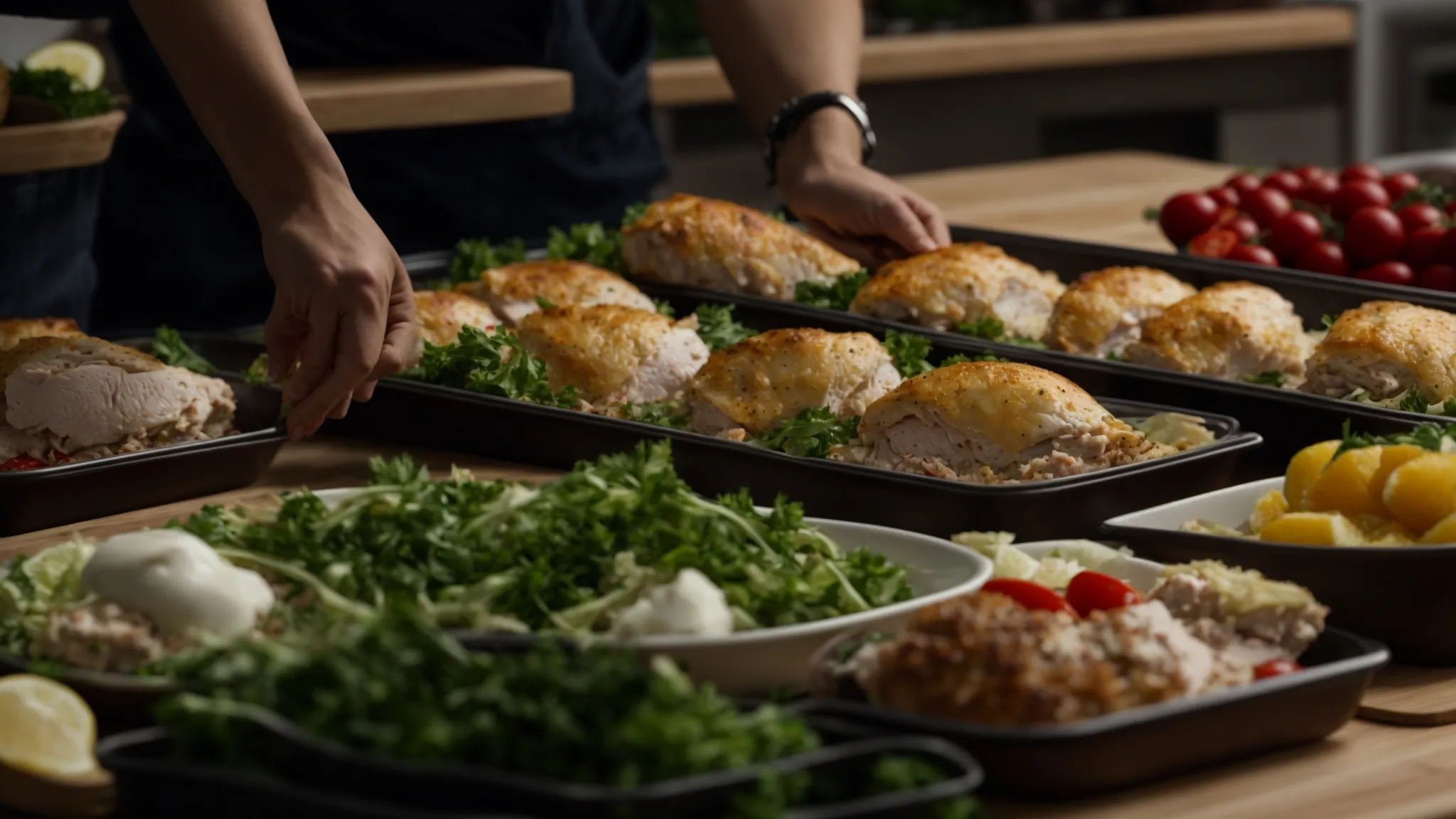
Embarking on the journey to a sumptuous meal, selecting spinach ricotta stuffed chicken ideal chicken breasts sets the foundation for this hearty recipe. I ensure these cuts are plump and uniform, allowing even cooking and optimal absorption of the flavors we’ll layer into them. Handpicking stuffing ingredients then becomes my next priority, focusing on fresh bread crumbs and robust seasonings that will impart a rich depth to our chicken as food and not just a protein. It’s the combination of herbs and spices, carefully chosen, that truly elevates this dish, mingling warmth and zest in each forkful. Of course, before the magic happens, preparing your cooking station is essential; all surfaces pristine, utensils ready, and heat regulated to keep things under control – this is how I set the stage for culinary success. As for the vital components like water and sauce, they’re not merely extras, they play their roles in maintaining moisture and enhancing the juicy tenderness our stuffed chicken breast promises.
Selecting the Perfect Chicken Breasts
My first step is to hand-select the meat for our baked chicken and ricotta meatballs adventure. I look for chicken breasts that are firm to the touch and have a pale pink hue, indicating their freshness. Without the right base, all the fragrant additions of garlic and fresh herbs would be for naught.
Quality in chicken breasts is non-negotiable; ideal candidates are those without bruises or blemishes. This ensures that the meat will cook evenly, whether simmering on the stove or enveloped in heat within an oven. As I choose the chicken, I envisage the succulent result, anticipating the perfect harmony with our savory zesty Greek chicken stuffing.
Not to be overlooked, the size of the chicken breasts is a key factor that plays a pivotal role in the cooking process. I steer clear of excessively thick cuts that would require longer baking times and perhaps dry out, but also avoid overly thin ones that could end up tough. Achieving that fine balance leads to a chicken that’s beautifully roasted and ready to complement the zesty punch of garlic and herbs we’ll introduce zesty Greek chicken.
Choosing Your Stuffing Ingredients
Embarking on the selection of stuffing ingredients, I give precedence to the bread’s texture—it must be hearty enough to hold up during baking, yet tender enough to complement the moist chicken breast zesty Greek chicken. Infusing the bread with aromatic herbs also accounts for a layer of flavor that is subtly released with each bite. I particularly enjoy the interplay of rosemary and thyme, as they lend an earthy sophistication to this comforting classic.
Preparing for the grilling brings my focus to the cheeses that will grace our stuffing. A medley of sharp and mellow cheese, precisely measured, will impart creamy richness to the mixture. A dish like this heralds a beautiful mess, where the cheese melts into crevices and swirls with the herbs, becoming part of an indulgent baked chicken and ricotta meatballs that turns ordinary chicken into a feast for the senses.
The element of cream cannot be understated, as it binds the stuffing components together and enhances the flavors. It’s key to establish a smooth, spreadable consistency that nestles snugly inside the chicken, ensuring that every slice of spinach ricotta stuffed chicken is moist and aromatic. This culinary step, seemingly minor, is the secret to a stuffing that is both luscious and structurally sound, supporting the ensemble as it cooks to perfection.
Herbs and Spices for Extra Flavor
In the realm of savory dishes, herbs and spices are the silent heroes that infuse life into every casserole. I regard them as the soul of the meal, where a simple sprinkle of basil or a dash of oregano can take a chicken breast from ordinary to memorable. When combined with the heat of the oven, these fragrant additions beautifully merge into the buttery juices of the chicken, creating a symphony of flavors.
Beyond the palette of greens and yellows from herbs and spices, the essence of butter is a non-negotiable in my kitchen. It imparts a luxurious mouthfeel to the herb stuffing, an essential counterbalance to the leaner baked chicken and ricotta meatballs meat. In the oven’s embrace, this blend of butter and herbs yields a crust that’s golden and enticing, a perfect shield for the juicy goodness within.
To enliven the dish, I draw from the earthiness of soup stocks and the indulgence of rendered fat—these components act as my flavor conductors. They ensure the bouquet of herbs from the zesty Greek chicken intensively pervades every molecule of the chicken:
- Mixed with fat, the spices cling to the flesh, deepening the taste profile.
- Brushed onto the skin, the herbed butter mixture helps to seal in moisture.
- When deglazing, the soup stock unfurls all the concentrated pan clusters into a sauce that blanket the meat in additional zest.
Their partnership is what allows this dish to achieve its legendary succulence that has my guests eagerly leaning towards the dining table with anticipation.
🥗 Fresh, Fast & Foolproof — Upgrades You'll Use Tonight

- Zoodles in seconds
- Heavy-duty, 10 sharp blades
- Keto, paleo & gluten-free friendly

- Meals in ~30 minutes
- 3-Qt — perfect for 1–3 people
- Pressure cook, sauté, steam & more

- Phone alerts & live temp graph
- Hands-off monitoring for smokers
- Perfect doneness, every time
Preparing Your Cooking Station
Before diving into the heart of our cooking endeavor, I like to prime my kitchen with all the necessary tools, ensuring a seamless culinary journey. I set up my slow cooker, a trusty companion for keeping baked chicken and ricotta meatballs warm, ready for those who fancy a lighter broth with their meal.
Ensuring my countertop is clutter-free, I reserve a spot for a vibrant, fresh salad that’ll offer a crisp counterpoint to the zesty Greek chicken. Every seasoning, especially black pepper, is placed within arm’s reach, strategically positioned to enhance the flavors at a moment’s notice.
Just as a child values a favorite toy, I value my kitchen gadgets that play vital roles in the crafting of this dish. Tongs, spatulas, and a sharp chef’s knife are all at the ready, prepared to handle the chicken, baked chicken and ricotta meatballs, and spinach ricotta stuffed chicken with precision and care, poised to transform simple ingredients into a culinary masterpiece.
Step-by-Step Instructions to Stuff Chicken Breast
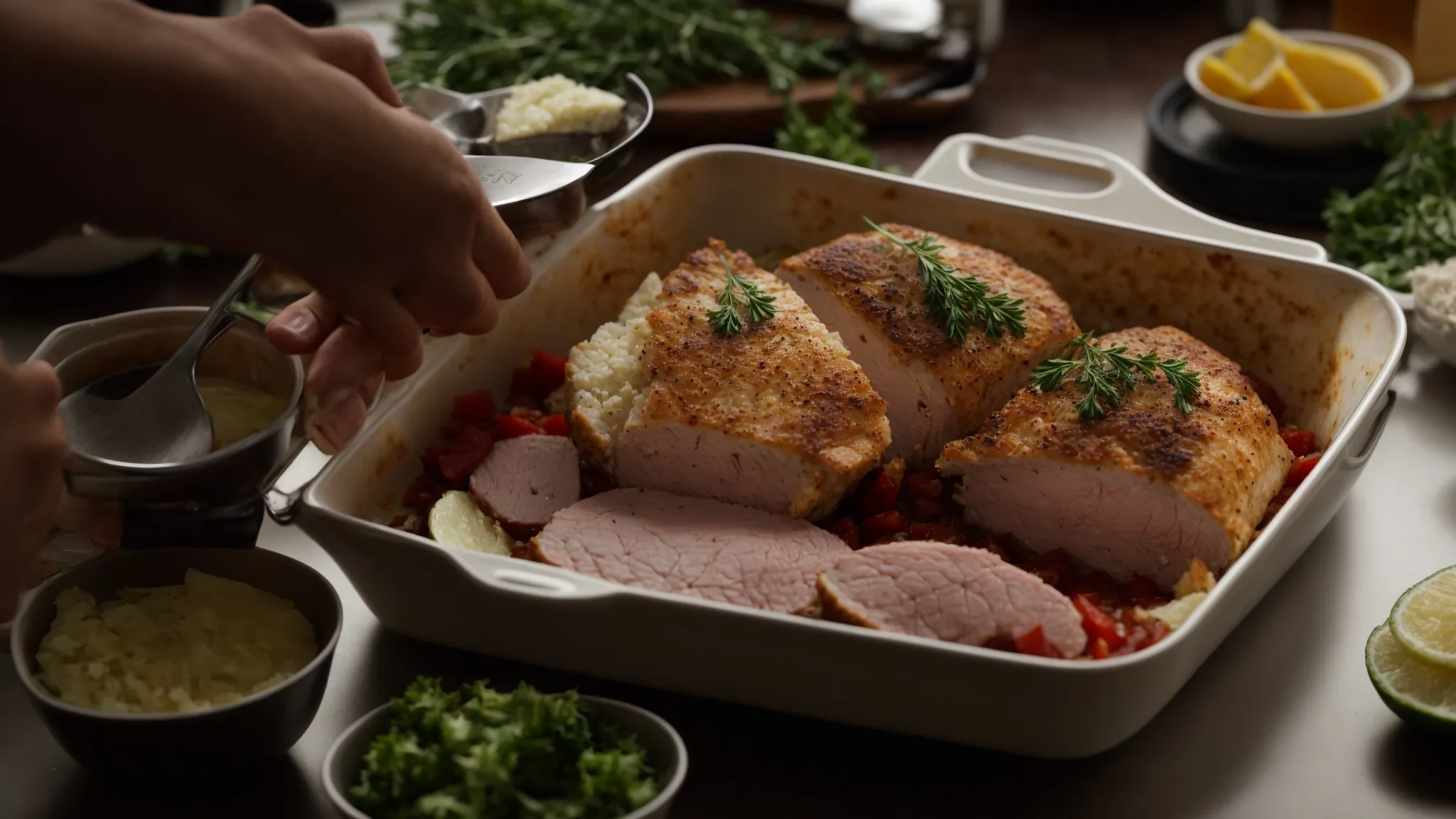
Now, as we roll forward like a cart brimming with fresh produce, let’s turn our attention to dressing the chicken for its flavorful journey. The task at hand involves a blend of preparation and technique—starting with fashioning a pocket in the spinach ricotta stuffed chicken ample enough to hold our robust stuffing. With my fingers, I gently coax the meat, mindful not to puncture through, creating a vessel that will cradle the mingling flavors of onion, vegetable, and a bouquet of herbs. Next comes the marination phase, simply seasoned to complement the richer notes of the zesty Greek chicken stuffing. I’m captivated by the thought of the chicken immersing in a gentle broth, hints of what’s to come permeating its fibers. The filling, a savory assembly of ingredients I’ve selected with intention, waits patiently for its moment. It’s the turn of my hands to artfully introduce the bread cubes, vegetables, and seasoning into the chicken, using a practiced stuffing technique that ensures even distribution without overfilling. Lastly, a careful finesse is needed to secure the chicken breast, preserving all that’s inside for the cooking process. Each step, executed with precision, promises an outcome of rich, savory delight.
Preparing the Chicken for Stuffing
As I embark on the meticulous process of preparing chicken for stuffing, the kitchen transforms into a stage where the poultry becomes my star performer. Paring the breast to create just enough space for the filling leaves you with a sense of anticipation for the flavors you are about to seal within. It’s about precision—ensuring that each cut contributes to the dish’s overall balance of nutrition and delight. If you want some inspiration for stuffed chicken recipes, you can visit Luscious Recipes for recipes like spinach ricotta stuffed chicken or zesty Greek chicken.
The potato, though humble in its roots, plays a crucial role in our stuffing blend. Its starchy goodness readily absorbs the seasoning, lending a comforting mouthfeel that pairs flawlessly with the tender chicken. It’s this thoughtful combination that contributes both taste and texture, elevating the dish from simple poultry fare to a nuanced ensemble of flavors.
With all components ready, I lay out the recipe steps before me:
- Carefully cut pockets into the chicken, being mindful of their size and depth.
- Season the potato and mix it with the other stuffing ingredients to enhance its flavor profile.
- Gently fill the chicken breasts, balancing the filling evenly to ensure each bite is as satisfying as the last.
These steps will guide the transformation of these individual elements into a cohesive, flavor-packed dish that promises to be as nutritious as it is delectable.
Mixing the Savory Stuffing
With each ingredient at the ready, I begin crafting my stuffing, taking special care to season it with just the right amount of salt. The salt, not too liberal yet sufficient, ensures the flavors meld without overpowering the delicate thyme leaves that I fold in with a gentle hand.
My kitchen fills with a comforting aroma as I heat the milk to a gentle simmer on the stove top, ready to soak the bread cubes for the stove top stuffing. This warm bath will turn them into soft sponges, eager to absorb the essence of herbs and spices, locking in moisture for a tender bite.
After mixing the ingredients, I transfer the stuffing into a bowl and slide it into the refrigerator to cool. Chilling the stuffing is a strategic pause in my process: it thickens the mixture, making it easier to handle and stuff into the chicken breasts without it falling apart:
Stuffing Technique for Chicken Breast
My approach to stuffing the chicken breast begins with a delicate hand, weaving the green bean pieces into the bread base. The vibrant green cuts through the rich gravy that I’ll serve alongside, balancing the plate like the perfect side to a sumptuous fried chicken meal, yet here, it’s encased within our elegant chicken centerpiece.
After preparing our herbaceous bread stuffing, I prioritize evading over-stuffing, which can lead to a less than desirable result. As I spoon the filling into each pocket, I’m reminded of careful layering similar to assembling a baked pasta dish, ensuring evenness and avoiding any overstuffed bulges that might struggle to remain enclosed during the cooking process.
Sealing the stuffed breasts is an act as critical as crafting the stuffing itself; a meticulous crimping of the edges ensures none of the hearty filling escapes. It’s reminiscent of securing a calzone or pie where the goal is to retain all the rich, warm goodness inside, promising a juicy bite that harmonizes beautifully with the crisp texture of fried chicken or a creamy pasta twirled on a fork.
Secure the Stuffed Chicken Breast for Cooking
With the filling nestled snugly within the poultry, I turn my attention to a staple accompaniment, cream of mushroom soup. It’s a simple addition that provides a savory backdrop, transforming this meal into an indulgent affair where each teaspoon added deepens the dish’s comforting appeal.
The process demands precision, and as I lay the filled breast in a hot frying pan, I marvel at the sizzle signaling flavors marrying under the heat. A delicate sear on each side ensures the edges of the chicken cling to the stuffing, infused with hints of celery that promise a symphony of rustic flavors.
Securing the chicken for cooking means judging not just the heartiness of the filling but the entire meal’s composition. I aim for a golden-brown sear that whispers promises of a thoroughly cooked, savory chicken underlain with the tender embrace of cream of mushroom soup and aromatic vegetables.
Best Practices for Juicy Stuffed Chicken
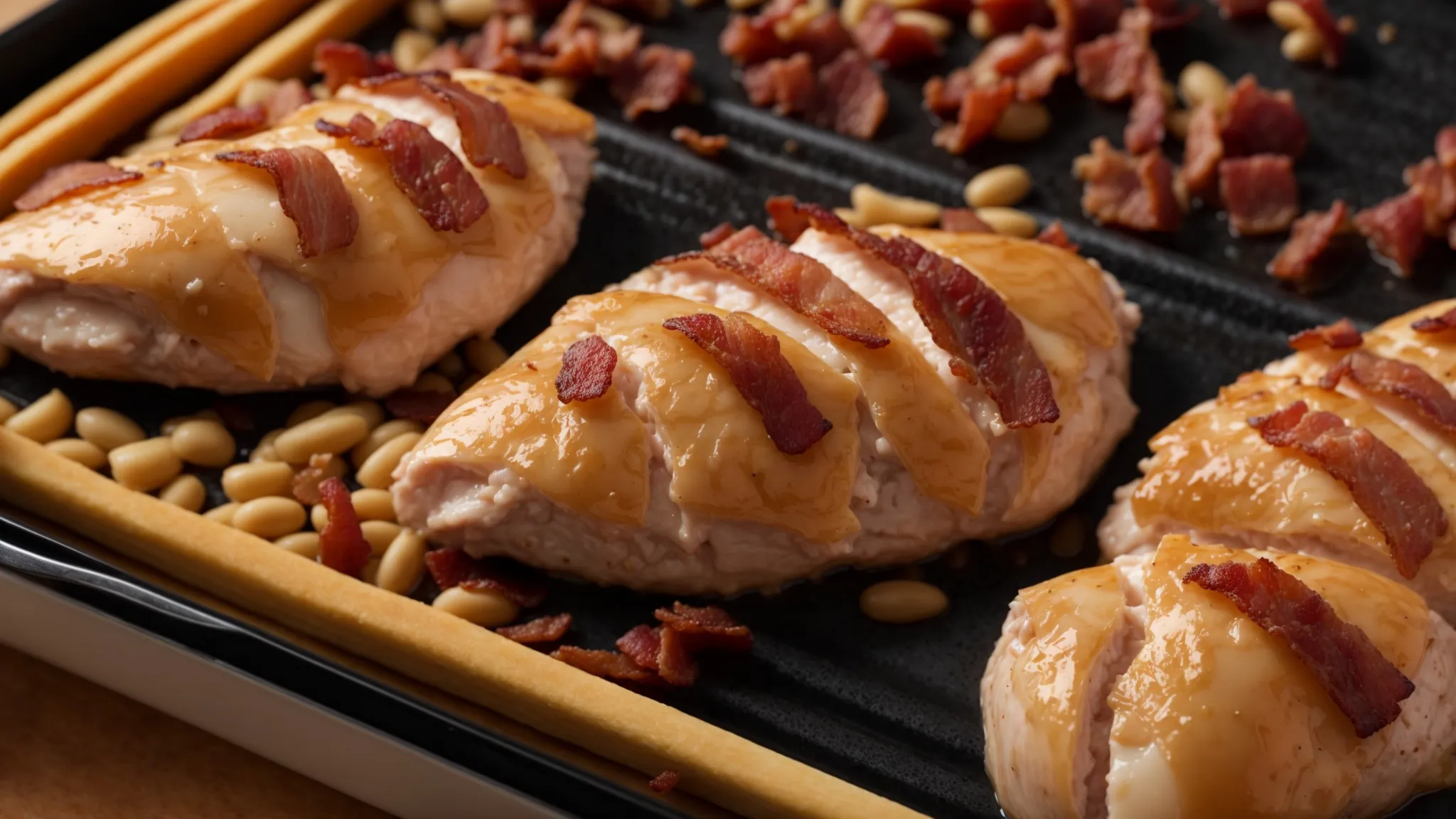
Getting our chicken to that perfect state of juicy tenderness is more science than art, requiring a keen understanding of oven temperatures and cooking time. Weaving through the process, one must tread carefully to prevent the meat from drying out, conserving the succulence that elevates this dish from good to great. In my kitchen, I’ve learned that proper seasoning with a judicious eye, perhaps integrating the smokiness of bacon into the mixture for an extra dimension of flavor, plays a critical role in moisture retention. I keep a bowl at hand for assembling the various components, ensuring that each chicken breast is lavishly coated and ready for the oven. Including a bean in the stuffing, provides not just interesting texture, but also helps to maintain internal moisture. With a meat thermometer as my trusted ally, I feel empowered to pinpoint that exact moment when the chicken is impeccably cooked—completely safe to eat yet sumptuously moist—effectively turning a simple meal into an extraordinary experience.
Oven Temperature and Cooking Time
Setting the oven to the right temperature is essential for transforming a simple chicken breast into a culinary masterpiece with a tender center and a golden crust. I prefer warming the oven to a cozy 375°F (190°C), a temperature that allows the chicken to cook through gently without sacrificing moisture. Amid the heat, the subtle touch of parsley and lemon infuses the meat with vibrancy, pairing seamlessly with the rich herb stuffing.
To lock in the harmony of flavors and ensure precise cooking, I keep a watchful eye on the timer. Approximately 25-30 minutes is the sweet spot, depending on the size of the chicken pieces. This duration allows the luscious stuffing, with its bits of tomato and herbs, to reach a safe and palatable temperature while keeping the calorie count in check by avoiding prolonged cooking and excessive oil absorption.
Nearing the end of the cooking cycle, I attentively monitor the chicken with a meat thermometer for the ideal internal temperature of 165°F (74°C). This precision allows the stuffed breasts to remain succulent, ensuring the juices mingle with the pillow of stuffing, resonating with the tang of lemon and the robust flavor of tomato, culminating in a dish that is as nourishing as it is flavorful.
Tips to Prevent Dry Chicken
Dryness in chicken, that unwanted guest, can often ruin what otherwise would be a delightful meal. To keep it at bay, I regularly incorporate spinach into my stuffing – a leafy green that not only packs a nutritional punch but also retains moisture. This blend ensures that every bite of the chicken breast is infused with moistness, creating a harmonious balance with flavors that lingers, even as leftovers.
As someone with a penchant for succulent chicken, I’ve discovered that a slow cooking method can be my closest ally. Maintaining an even, lower temperature is like treading softly through a field, allowing the breast meat to gradually come to temperature without becoming tough. I consider accessibility during cooking, keeping the chicken covered and bathed in its juices, weaving a safety net around the meat to protect its tenderness throughout the baking process.
My kitchen is my haven, and in it, I’ve learned the value of rest time after the oven’s heat has worked its wonders. Allowing the stuffed chicken breast to settle, akin to letting a rabbit pause in its burrow, gives the juices a moment to redistribute. This small but critical step ensures that when sliced, the chicken remains as moist and inviting as one could hope for, transforming the simple act of re-plating into a continuation of the culinary ritual.
Using a Meat Thermometer
Utilizing a meat thermometer is a tactic I rely on heavily, especially when experimenting with additions like a tablespoon of curry, which does not just add a burst of flavor but also affects the cooking process. By probing the chicken, I confirm the safe culinary threshold has been met, all while ensuring that flavorful infusions like a hint of mushroom or a dash of curry have thoroughly permeated the meat. This tool is indispensable for gauging doneness, eliminating the guesswork and delivering consistency, bite after delectable bite.
Integrating rice into the stuffing presents another variable in my cooking equation, one that requires precise timing to achieve that perfect fluffy texture. Here, the meat thermometer becomes my culinary compass, guiding me to that peak moment when the stuffed chicken breast reaches the apex of juiciness while the mushroom-rich filling with rice swells to tender perfection. It’s a humble piece of technology that transforms a simple practice into a fine art.
A final check with the meat thermometer guarantees the chicken is cooked through yet remains succulent. Every second counts like timing a perfect cookie, aiming for that sweet spot where it’s delightfully done but not a second overbaked. With this trusty device, I’m assured that my stuffed chicken breast, layered with complex flavors including a tablespoon of aromatic curry, delivers warmth and comfort in every forkful.
Delicious Side Dishes to Complement Your Meal
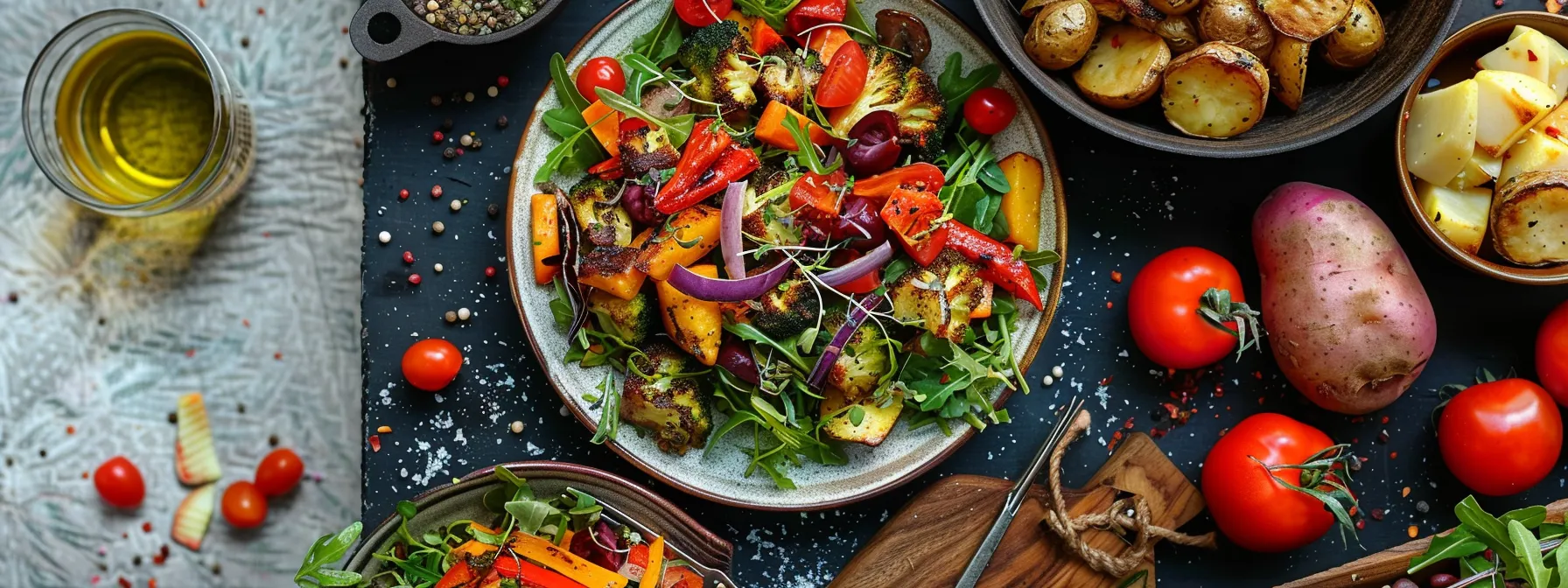
Once you’ve mastered the art of creating a succulent stuffed chicken breast, the next step is to round out your meal with sides that complement the main dish. Crafting the perfect plate involves more than just cooking techniques; it’s about textures, flavors, and nutrition. Light and fresh salads sprinkled with a bit of egg for protein, or a dash of parmesan to elevate the taste, bring a crisp contrast to our comfort food centerpiece. On the nutritional side, incorporating a variety of steamed or roasted vegetables not only adds vibrant color to your plate but also infuses your meal with essential vitamins and dietary fiber. And let’s not forget the universal appeal of potatoes, whether whipped to fluffy perfection, roasted with herbs, or sliced into elegant gratins. These starch-rich sidekicks are the perfect pairing, creating a symphony of flavors that make every dining experience truly complete.
Light and Fresh Salads
A zesty salad offers a refreshing counterpoint to the rich flavors of our main dish. I love to toss a crisp green salad with thinly sliced pork for an added dimension of flavor. The key is a light touch with the oil-based dressing, enhancing the fresh produce without overshadowing the subtle notes of the rest of the meal.
While the dutch oven works its magic, braising meats to tender perfection, I enjoy the simplicity of preparing a salad. A bowl of mixed greens punctuated with juicy tomatoes feels like the perfect accompaniment to a spread that features decadent mains, such as mashed potato enriched with butter or the smoky allure of barbecue.
There’s an art to balancing the plate both in terms of flavors and textures. As the chicken breast stuffed with hearty stuffing emerges from the oven, I turn to a salad that promises crunch and vibrancy. It becomes an essential element of the meal, cutting through the richness with its airy quality, dressed lightly in a homemade vinaigrette that complements without competing.
Steamed or Roasted Vegetables
My go-to for a balanced plate is a vibrant array of steamed broccoli, which not only offers a crunchy contrast to the stuffed chicken but is also a nutritional powerhouse. A light drizzle of a mustard and sour cream dressing over the broccoli infuses a creamy tanginess, creating a dish that is as visually appealing as it is delicious.
Understanding the need for a variety in texture, I often turn to roasted vegetables as a heartier complement to the meal. Oven-roasted to caramelized perfection, they bring out the natural sugars, adding a subtle sweetness that contrasts beautifully with the savory depth of the chicken breast stuffing.
I am mindful of those who may be watching their carbohydrate intake, which makes these vegetable sides an excellent option. Steamed or roasted, they offer a lower-carbohydrate alternative to traditional starches, allowing guests to indulge in a sumptuous meal without the guilt of excess sugar or carbs.
Perfect Pairing With Potatoes
As I tenderly prepare potatoes to accompany the stuffed chicken breast, I envision them as nature’s gift card to a world of culinary delights. Roasting them on a sheet pan until they’re golden and crispy unlocks a cozy depth of flavor that harmonizes with the main dish, enhancing the meal without adding undue saturated fat.
Depending on the evening’s theme, sometimes I metamorphose the humble spud into something more elegant, dusting them with a bit of flour for a light crust as they roast. This approach creates a delightful contrast in textures, with the outer crispness giving way to a soft, fluffy heart, that marries well with the rich juice seeping from the savory stuffed chicken.
In light of health-conscious choices, I often prepare potatoes without excess additions, allowing their natural earthiness to shine through. It’s a simple gesture, a subtle nod to wholesome eating that aligns with the nutrient profile of the entire meal, providing satisfaction without the remorse of excessive saturated fat.
How to Make a Homemade Gravy From Pan Drippings

After indulging in the luxurious taste of a stuffed chicken breast, there’s one more secret to elevate our meal to new heights—the creation of a homemade gravy rich with pan drippings. This final touch, simmering on the stove, tempts all senses, with its deep, savory notes heightening the already warm tones of the dish. My next steps involve artfully collecting those precious juices left in the pan, which encapsulate the essence of our roast. The choice of thickener, be it flour or cornstarch, becomes a pivotal decision, affecting both texture and the graceful way it clings to a ladle. Of course, personalizing the gravy with seasoning is a delicate task, as I skillfully wield sodium, spice, and the classic duo of salt and pepper to achieve a perfect balance—each spoonful enhancing the juicy chicken and creamy feta within the stuffing. It’s this final flourish that transforms a great meal into a symphony, where the gravy serves not merely as a side dish but as the conductor, uniting each component on the plate in delicious harmony.
Collecting the Pan Drippings
As the chicken breasts finish cooking, my kitchen becomes the backdrop for the next critical phase: harvesting the pan drippings. Over the stove, I gently tilt the pan, using a spoon to collect the glistening juices that have mingled with the hearty essence of the protein.
The savory drippings are a treasure in themselves, carrying the concentrated flavors of the chicken and the subtle notes of the stuffing. In my collection dish, I take care not to waste a single drop of this culinary gold, already imaging how it will elevate the accompanying gravy with a robust depth, unmatched by any store-bought version.
My anticipation grows as I prepare to transform the drippings into a mouthwatering gravy. The combination of beef stock and a splash of cranberry juice will soon create a sauce that not only complements the stuffed chicken but brings out the richness of each ingredient:
Flour or Cornstarch for Thickening?
Deciding between flour and cornstarch is like choosing the perfect cheese for a pizza; each has its unique qualities. Cornstarch is my go-to for a silky, glossy sauce as it has twice the thickening power of flour and creates a transparent sheen not unlike the melty strands of mozzarella over a bubbling pie. However, it requires a careful hand to avoid lumping, similar to ensuring an even spread of cream cheese for bagels.
I opt for flour when I’m after a gravy with more heft, similar to how a juicy steak needs a robust sauce. The iron skillet, still fragrant from roasting the bird, cradles a roux made with flour; it’s cooked until it reaches a golden hue, building a deep, nutty flavor in the base of my gravy. This foundation marries beautifully with the concentrated drippings, transforming them into a velvety sauce that begs to be poured over the stuffed chicken breast.
Flour, just like cornstarch, has its special moment depending on the desired outcome of the dish. If I want the richness to linger on the palate, flour is the secret; its protein content creates a heartier texture that clings to the chicken, much like cream cheese binds with other flavors to enrich a sauce or dip. Mozzarella melts over a steak sub also behaves similarly, becoming the oozy glue that brings all the components together.
Seasoning and Serving the Gravy
Once the rich pan drippings are collected, it’s time to stir in the stock, adding another layer to our gravy’s flavor profile. While the chicken rests, I whisk in a vibrant splash of olive oil, which melds into the sauce, giving it a luxurious silkiness. Finishing with a sprinkle of paprika doesn’t just lend a smoky undertone; it also enriches the sauce’s color to a russet hue — perfect for drizzling over a freshly carved chicken sandwich.
With the gravy simmering and thickening, I consider its nutritional angle, sneaking in a bit of vitamin C where I can. A squeeze of lemon brightens up the mix, breaking through the richness to add a zesty contrast. My eyes anticipate that first pour over the golden chicken, knowing the olive oil has rounded out the edges of flavor to create a sauce that’s both hearty and nurturing.
Serving the gravy is an act of presentation as much as taste. The sauce, smooth and aromatic from the paprika’s deep notes, is ready to crown the plate. Garnishing the chicken sandwich with a generous spoonful, I ensure not to overflow, for the ideal dining experience is about balance — the poultry’s moistness and the gravy’s bold identity in harmonious tandem.
Creative Variations of Stuffed Chicken Breast
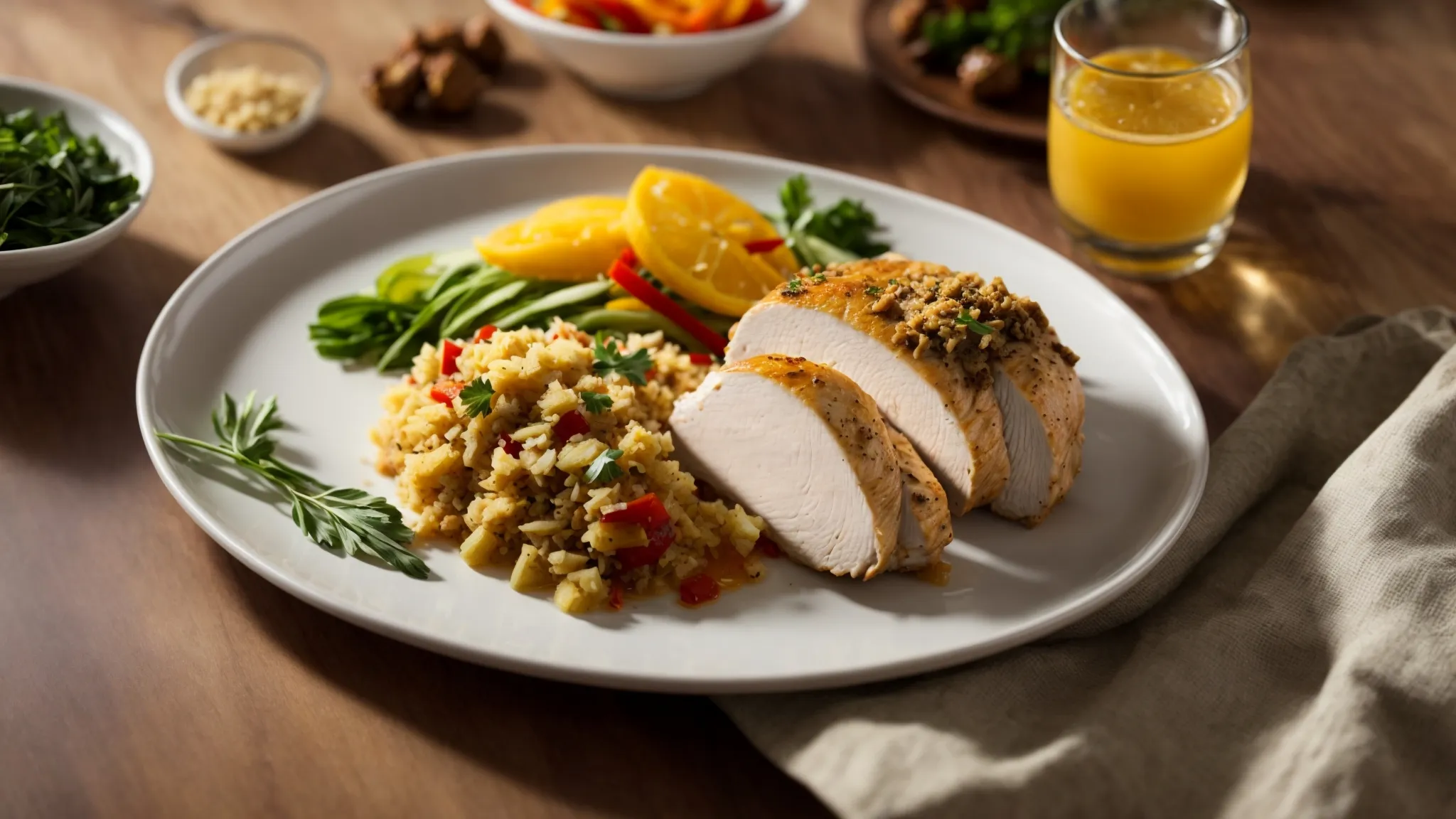
Expanding our culinary horizon beyond the traditional, I delight in exploring fresh stuffing inspirations that can transform the stuffed chicken breast into a showcase of global flavors. Whether folding in spices reminiscent of distant lands or substituting the usual bread base with an exotic grain, the possibilities for creativity astound me. With a nod to health-conscious eaters, adaptations cater to those monitoring their cholesterol or seeking less sodium, offering meat alternatives like lean sausage filled with potassium-rich ingredients. Moreover, basting chicken in a flavorful brine transcends it to succulence without the excess calories, while the art of transforming a simple dish into a refined experience reminds me of skilled taxidermy, though far more appetizing and nourishing. Tailoring the chicken’s stuffing to meet dietary restrictions is more than accommodation; it’s an adventure in texture, taste, and nutrition—giving rise to dishes that comfort and impress in equal measure.
Different Stuffing Inspirations
Whenever I reminisce about thanksgiving, those familiar scents and flavors inspire me to innovate stuffed chicken in similar fashion. Integrating a blend of sage, celery, and cranberries pays homage to the holiday, transforming an everyday meal into a special occasion. It’s that handcrafted mixture of tender poultry with a thanksgiving-themed stuffing that evokes warmth and festivity, regardless of the season.
A sweet and sour twist in my stuffing is a surefire way to awaken the palate’s full spectrum. By combining tangy pineapple with a hint of brown sugar, the stuffing takes on an irresistible contrast, challenging the classic savory notes of the chicken. This sweet and sour profile brings a delightful surprise to the table, pairing the complexity of flavors with the comfort of a home-cooked meal.
In my quest for fresh, out-of-the-box stuffing ideas, I’ve drawn inspiration from diverse corners of culinary tradition. Imagine the delicate layers of a noodle pie with chicken, where a ricotta and spinach mix, intertwined with al dente pasta sheets, replaces standard bread stuffing. This fresh approach not only infuses variety into the repertory but also adds an intriguing textural contrast, turning the stuffed chicken breast into an inspired noodle-centric entrée.
Incorporating World Flavors
Flipping through my cookbook, I often get the urge to infuse global zest into my kitchen creations, elevating a simple chicken dish to worldwide acclaim. A sprinkle of garlic powder, the humble yet powerful spoon that stirs cultures together, has the ability to transport my stuffed chicken breasts to the aromatic streets of far-off nations.
The allure of recreating a traditional turkey recipe with a worldly twist has been an invigorating challenge in my culinary pursuits. Substituting chicken with turkey infuses a new character into the meal, translating well-known flavors into something novel while introducing the benefit of more polyunsaturated fat to my diet.
Taking cues from an array of international cuisines reinvents the stuffed chicken experience for both gourmet lovers and family diners alike. A delectable spoonful of this richly stuffed poultry promises a journey of tastes, from the Mediterranean to the shores of Asia:
- Collect world-inspired seasonings and prep the meat with a nod to traditional practices.
- Combine garlic powder and chosen spices with a healthy sprinkle of culinary creativity.
- Use turkey as a substitute for chicken when desired, adjusting cooking times as necessary.
Recipe Adaptations for Dietary Restrictions
When thanksgiving dinner rolls around, dietary restrictions should not prevent anyone from enjoying a stuffed chicken breast feast. To adapt the stuffing for gluten-sensitive guests, I swap out traditional bread crumbs for a rice-based blend, packing it with herbs and root vegetables. This small but inclusive modification allows everyone to savor the meal as equally as they cherish the holiday spirit.
Using foil as a cooking medium delivers more than just moisture retention; it serves as an ingenious solution for those who must steer clear of the ubiquitous frying. Wrapped snugly, much like a teddy bear in a child’s embrace, the chicken is allowed to cook gently in its own juices. This method not only ensures a succulent meal but also aligns perfectly with low-fat dietary preferences.
- Select gluten-free alternatives for the stuffing base to accommodate sensitivities.
- Employ foil wrapping as a healthy cooking alternative that preserves juiciness.
- Avoid frying, opting for gentler cooking methods suited to low-fat diets.
Meanwhile, a rotisserie-style preparation offers another avenue for healthful indulgence, one that’s particularly well-suited for low-sodium diets. As the chicken turns gracefully, basted with its natural juices, the need for added salt fades, and the true essence of the seasoned stuffing comes to the forefront, offering a succulent taste experience without compromising dietary guidelines.
How to Store Leftover Stuffed Chicken Breast

After savoring the delectable combination of tender chicken and savory stuffing, replete with herbed bread crumbs and harmonious spices, one might find they have a portion of their meal remaining. I’m attentive to the reality that the delicious essence of this dish, descended from the red junglefowl, should be treasured and preserved for future enjoyment. Practical knowledge about proper cooling and refrigeration tips is essential to maintaining the dish’s quality and safety. Keenly aware of the drying heat from sautéing that transformed raw chicken into a succulent meal, I ensure any reheating process captures that original moisture, keeping the meat just as tender as during its first serving. Knowing well that the generous calcium content in the cheese should not go to waste, I also employ useful techniques for freezing stuffed chicken breast, transforming my humble crock into an archive of gastronomical delights for future meals.
Cooling and Refrigeration Tips
Storing leftover chicken requires the same care as setting a seafood buffet on ice—safety and freshness are key. I cool my leftover chicken cutlet swiftly to prevent bacterial growth, which is just as vital as picking the freshest catch for a seafood dish. Once at room temperature, into the fridge it goes, sealed in air-tight containers to prevent the mingling of flavors and maintain that perfect blend that turns chicken salad from ordinary to extraordinary.
As I wrap up dinner, reminding myself to share this stellar recipe with friends via email address, I tuck the leftover stuffed chicken cutlet next to my treasured unicorn of dessert leftovers—a rare treat, enjoyed twice. In the chilled sanctuary of the fridge, I place it at the front, ensuring a quick retrieval for tomorrow’s lunch where, with a sprinkle of creativity, it’ll be reimagined into a hearty chicken salad.
Ensuring leftovers retain their allure is akin to nurturing a garden of culinary delights; my chicken breast, now a cutlet of sorts, requires a cold environment reminiscent of a salad bar’s chill. It sits, a solitary gourmet offering amongst jars and bottles, and there’s a silent promise that within 3-4 days—before providing my email address to inquiring friends for the recipe—it will transform into a lunchtime indulgence, a rewarding chicken salad that recalls the previous night’s warmth.
Reheating Without Drying Out the Chicken
Reheating the chicken calls to mind the delicate balance needed in poultry farming to produce that perfectly moist bird every time. To ensure the reheated chicken breast retains its juiciness, I use a low oven temperature, wrapping the meat in foil to trap the moisture. Just like smoke enhances the flavor of lamb and mutton, this method gently warms the chicken, allowing it to heat through without losing its tenderness.
While I rarely venture beyond the essentials, considering sides like french fries does lead me to an inventive approach when rejuvenating leftovers. I prefer to reheat the chicken in a skillet over medium heat with a touch of broth, creating a steamy environment that moistens the poultry as if it’s freshly roasted, thwarting the potential dryness often associated with leftovers.
Reintroducing heat to leftover chicken ought to be as nuanced as the care given to raising the animal itself. In anticipation of preserving the original succulence, I opt for a short stint in the microwave covered with a damp paper towel. This method imparts a gentle steam, akin to a quick kiss of smoke, which envelops the chicken, re-invigorating it with moistness and ensuring a delicious second serving.
Freezing for Future Meals
My approach to freezing chicken begins with a liberal misting of cooking spray on the foil wrap; this ensures that once thawed, the chicken does not stick or tear, preserving its gourmet appearance. The chef in me knows that a dish is as much about visual appeal as it is about taste, maintaining the integrity of my culinary creation for meals to come.
Before nestling the stuffed breast into the cold expanse of the freezer, I add a drizzle of olive oil, lending a protective coat that will keep the chicken moist and flavorful. Incorporating olive oil is like sending a bottle of fine wine ahead of a long journey, providing a taste of luxury and care, even when consumed much later.
Although this dish isn’t your traditional cornbread, which stands up well to the freezing process, I treat the stuffed chicken breast with the same respect a chef gives to any fine bread-based preparation. Ensuring that the flavor and moisture are locked in, it’s routine for me to allow the chicken to cool completely before wrapping it for the freezer, safeguarding the meal’s future enjoyment.
Common Mistakes to Avoid When Making Stuffed Chicken
As we proceed with our culinary creation, I’ve learned that even the most crafted recipes can be unraveled by simple oversights. Patience is the key when it comes to avoiding the pitfall of overstuffing the chicken breast. It’s tempting to load up on that cheddar cheese and inviting stuffing, but moderation ensures the breast remains intact and cooks evenly. Similarly, I stay vigilant with my thermometer—it’s more than just a tool; it’s my guide to achieving that flawlessly tender chicken complemented by a golden-brown crust. The importance of setting the oven to the right temperature cannot be overstated, particularly when dealing with sensitive proteins. And after bringing all the elements together—those juicy breasts packed with a delightful mixture, hints of cranberry sauce for that tangy sweetness, or perhaps a kick from spices like jerk—it’s crucial not to skip the resting phase. Allowing the meat to relax, the juices to redistribute, and the bone to transfer residual heat is like allowing a fine wine to breathe, ensuring a succulent finish to our meal.
Overstuffing the Chicken Breast
Resisting the urge to overstuff the chicken breast is like an elephant carefully stepping around obstacles, a show of both strength and precision. In the pursuit of a meal that’s as nourishing as it is delicious, I remember that moderation is vital. Excess stuffing can prevent the chicken from cooking evenly, compromising the perfect blend of monounsaturated fats and vitamin A that makes for a well-rounded diet.
In my kitchen, achieving the right stuffing balance is as crucial as the spices I blend for an enchilada sauce. Overstuffing not only leads to a spillover mess but also risks the sumptuous moisture and flavor we aim for. A well-stuffed chicken breast, with room for the meat to envelop the filling warmly, results in a dish where every bite offers a unified burst of taste and succulence.
I consider each ingredient’s role from a dietician’s standpoint, mindful that a chicken breast well-stuffed, not overstuffed, optimizes nutrient intake. A little space left within the chicken embraces the heat, allowing vitamin-rich spinach or a touch of olive oil, packed with monounsaturated fat, to mingle elegantly throughout the cooking process, creating a dish that supports a healthy diet without skimping on flavor.
Incorrect Oven Temperature
As essential as choosing the right spices for a meatball, setting the correct oven temperature is paramount to a stuffed chicken recipe’s success. An oven that’s too hot might give you the crisp exterior of a butter chicken but leave the inside undercooked, while too low risks a texture similar to stew—uniformly warm but lacking crispness. Just like lasagna, every layer should be perfectly cooked, and a meat thermometer is an invaluable tool for this precision.
I’ve found that baking stuffed chicken at the wrong temperature can lead to as much disappointment as a soggy meatball. Even if all other steps are meticulously followed, without the appropriate heat, the chicken can’t develop the golden crust that contrasts so beautifully with the moist stuffing. My aim is to replicate the layering effect one would appreciate in a lasagna, with textures diverse and pleasing to the palate.
An attentive eye to the oven’s settings is as crucial to poultry as the simmer is to stew. Therefore, I rely on not just my oven but also a meat thermometer to ensure accuracy. Unlike the forgiving nature of a butter chicken sauce, the stuffed breast has little room for error, and precise temperature leads to a dish that is tender, flavorful, and perfectly browned—just as every layer in a slice of lasagna should be discernible and deliciously cohesive.
Neglecting to Rest the Chicken After Cooking
In my meticulous approach to crafting the ideal stuffed chicken breast, I recognize the importance of resting. Skipping the resting phase is like rushing to crack open a peanut before it’s properly toasted – it lacks that final touch that enhances its flavor. After the chicken is cooked, allowing it to rest ensures that every ounce of savory juice redistributes, so when sliced, it’s as succulent as you’d hope for, not unlike the moisture you expect in a tender chicken finger.
I’ve learned that the magic of a well-rested chicken breast is undeniable. The time it spends away from the oven, basking in its residual heat, is crucial for locking in flavor. Even a pinch of onion powder won’t rescue the texture if the moisture escapes too soon, making rest time as essential to the perfect chicken breast as a wrapper to a muffin, containing its form and savoriness within.
Resting the bird isn’t idle time; rather, it’s an essential step in ensuring that the chicken breast remains tender and full of flavor. The same way a muffin needs time to cool and set after baking, a chicken breast needs to relax so each bite is a testament to the care taken during its preparation. Bypassing this crucial period can result in chicken that lacks that melt-in-your-mouth quality, diminishing the dining experience we aim for.
Sharing Your Stuffed Chicken Masterpiece
Now that we’ve crafted a stuffed chicken breast bursting with herb-infused flavors, the next step is to give your culinary creation the spotlight it deserves. In my experience, a platter arranged with precision is as alluring as the dish itself; think shawarma extravagantly displayed, revealing layers of meat and tempting spices, beckoning the diner to indulge. When arranging the chicken, I pay close attention to the golden-brown skin for aesthetic appeal, laying it upon a bed of vibrant greens or paired with garnishes like tender asparagus spears, ensuring every plate leaving my kitchen is a visual feast. For lovers of rotisserie chicken, this ensemble offers a homemade alternative, equally presentable straight from your kitchen without the rotisserie bag. Beyond the plate, sharing this experience extends into choosing a complementary wine that accentuates the rich stuffing—a selection process mirroring the curation of a good shawarma spice blend, needing just the right balance to perfect the meal. Finally, for those culinary moments we’re eager to share with the world, I ensure the lighting and framing capture the dish’s essence, reminiscent of how a well-organized farmer’s market stand draws the eye—every snapshot inviting likes and shares across social platforms.
Plating Techniques for a Stunning Presentation
When I arrange the stuffed chicken breast on the plate, I view my cutting board as an artist’s palette, laying the sliced meat in a way that reveals the spiral of savory stuffing inside. A thoughtful placement evokes the same meticulous care that goes into selecting antibiotic-free poultry for a wholesome chicken curry, ensuring a meal that’s as ethical as it is delicious.
I consider each plate I craft to be a silent citation of my culinary philosophy, where the aesthetics underscore the dish’s integrity. The creamy complexion of chicken divan, accentuated with vibrant greens, is framed on porcelain, echoing the finesse of a painter’s brush against canvas.
As the final act, I ensure that the chicken’s succulent exterior is showcased with flair, leveraging strategic lighting that highlights the golden-brown crust akin to the glossy coat of a well-prepared chicken curry. The dish becomes not just a meal, but a statement of my dedication to robust flavors and eye-catching presentations.
Pairing Wine With Your Stuffed Chicken
Choosing the right wine to accompany our stuffed chicken breast feels as graceful as a giraffe gallivanting across the savanna. A crisp white wine complements the tender white meat of the chicken perfectly, enhancing the herbs and spices infused within the stuffing without overpowering the delicate flavors. Like vegetarianism offers a fresh perspective on dining, a good wine pairing refreshes and refines the entire culinary experience.
For those evenings when the dish’s rich flavor profile stands front and center like a hit at the box office, I lean towards a Chardonnay. Its boldness holds up beautifully against the succulent chicken and savory stuffing, creating a palatable synergy much like a well-prepared onion soup warms and satisfies with its depth and complexity. This combination guarantees that each bite of chicken, chased with a sip of wine, is a ticket to culinary bliss.
Connecting the dots between a robust meal and a harmonious wine list, I understand the importance of balance. A glass of light-bodied wine with subtle fruity notes dances on the palate, cutting through the richness of the stuffing and elevating the white meat’s natural flavors. It’s the stitch in time that brings the entire dining experience together, much akin to finding harmony within a well-curated menu that caters to all, from omnivores to advocates of vegetarianism.
Capturing the Perfect Photo for Social Sharing
To share the appetizing visuals of this dish with others, getting that picture-perfect shot is crucial. I carefully arrange the plate in natural lighting, akin to how one would present a steaming, colorful bowl of noodle soup, ensuring the chicken with its rich fillings and golden crust is front and center. The contrast of textures and the enticement of the stuffing peeking out becomes a visual feast just as inviting as a christmas spread.
Capturing the essence of the dish involves more than just a snap; it’s about storytelling through imagery. I angle my lens to include a hint of the creamy gratin sidled up against the chicken, with pockets of melted swiss cheese that speak to the careful preparation and complementary sides. Each element of the photo aims to evoke a taste, scent, and warmth that garners attention and evokes hunger with just a glance.
Even though my dish isn’t the typical fare like fish, I aim for my photo to encapsulate the full-bodied experience of enjoyment, from the first cut into the juicy, herb-filled chicken to the last bite. Carefully, I adjust the focus and fine-tune the composition, creating a shareable picture that not only signals flair and flavor but also invites followers into a culinary journey of home-cooked sophistication.
Frequently Asked Questions
Can dogs eat raw chicken?
Yes, dogs can eat raw chicken, but it carries a risk of bacterial infection like salmonella, and it’s crucial to ensure it’s fresh and given in moderation to avoid any potential health issues.
How long can chicken last in the fridge?
Raw chicken can safely be stored in the fridge for 1-2 days, while cooked chicken lasts 3-4 days before quality diminishes.
How long can chicken last in the refrigerator?
Raw chicken can typically be kept safely in the refrigerator for 1-2 days, while cooked chicken should last 3-4 days when stored properly at or below 40°F.
How long does chicken last in the fridge?
Raw chicken can be safely stored in the refrigerator for 1-2 days, while cooked chicken remains good for 3-4 days when properly refrigerated at or below 40°F (4°C). Always seal it well to maintain freshness and prevent contamination.
How long will chicken last in the fridge?
Raw chicken can be safely stored in the refrigerator for 1–2 days, while cooked chicken should last 3–4 days before spoilage concerns arise.
What temperature should chicken be cooked to?
Chicken should reach an internal temperature of 165°F when measured with a meat thermometer to ensure it’s safely cooked.
What do chicken pox look like?
Chickenpox manifests as an itchy rash with small, fluid-filled blisters that eventually scab over.
Conclusion
Crafting a juicy stuffed chicken breast with savory stuffing is an act that marries tender poultry with rich, herbed filling for a harmonious bite every time. Mastering this recipe ensures a comforting and satisfying meal, elevating the humble chicken to a centerpiece of culinary delight. Key ingredients and cooking techniques work in tandem to preserve the chicken’s moisture and stuffing’s flavor, creating a nourishing dish that leaves guests impressed. This recipe not only showcases kitchen prowess but also brings a touch of elegance to the everyday dining experience.
🍳 Precision Meets Passion — Tools Chefs Trust Daily

- Grams & ounces — precise to 1g
- Perfect for baking & keto tracking
- Sleek stainless steel design

- German stainless precision
- Razor-sharp & dishwasher-safe
- Elegant wood block organizer

- WiFi precision cooking at home
- 1100W — heats fast & evenly
- Perfect steak, fish & veggies
